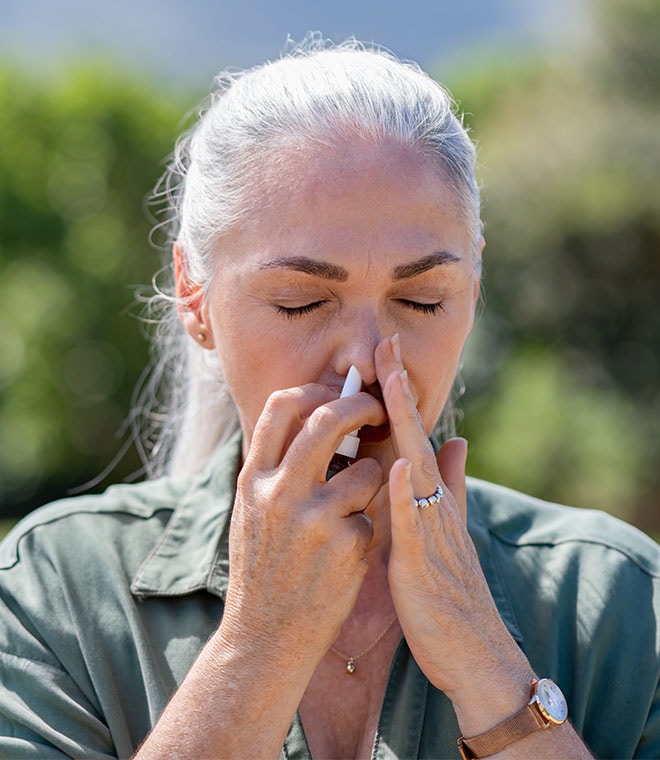Health
What are some tips for managing pet allergy symptoms?
By Sanjay “Jay” Patel, DO | Allergy & Immunology May 15, 2025 • 8 min
Pets are part of the family, but for some people, being around them can lead to allergy symptoms. Fortunately, there are steps you can take to control these symptoms if you have pets or frequently visit people who have pets.
What is pet dander?
Many people think that fur is the cause of pet allergies. However, that’s not usually the case. Pet dander is a more likely culprit. Dander is the term for particles of skin shed by pets. It can become caught in fur and transferred from a pet to people, clothing, furniture, carpeting and other surfaces.
Pet dander isn’t the only cause of allergies. Saliva and urine from certain animals can also trigger an allergic reaction in some people.
Why do allergies to cats and dogs occur?
Pet allergies occur due to the activities of the immune system. Ordinarily, your immune system protects you from microorganisms like bacteria and viruses by releasing inflammatory chemicals such as histamine. When you encounter something that can make you sick, this response can help fight off infections.
With pet allergies, your body mistakenly identifies proteins (also known as allergens) from your pets as a threat. In response to these allergens, your immune system releases histamine just like it would in the presence of germs. This can lead to allergy symptoms.
What are common pet allergy symptoms?
Cat allergies produce similar symptoms to dog allergies. You may be allergic to just one type of pet or experience symptoms around dogs, cats and other animals like horses, rabbits, hamsters, guinea pigs and ferrets. Some common pet allergy symptoms include:
- Itchy, watery eyes
- Eye redness
- Itchy nose
- Swelling around the eyes and nose
- Nasal congestion or runny nose
- Sneezing
- Coughing
- Hives
- Fatigue
For people who have asthma, pet allergies can worsen symptoms like shortness of breath, wheezing and coughing. They can also trigger asthma attacks.
Will a hypoallergenic pet help my allergies?
You may see some breeds of dogs and cats referred to as hypoallergenic. Although this label suggests that the pets are less likely to cause allergies, studies show that they are not truly hypoallergenic. People with pet allergies may experience symptoms when they come into contact with any breed. However, symptoms may be worse with certain breeds. Even hairless dogs and cats can trigger reactions since dander, urine and other substances are what cause allergies, rather than fur. Additionally, some people are allergic to pollen, which can stick to the fur when the pet is outside. When this happens, the pet can contribute to allergy symptoms even if they are classified as “hypoallergenic.”
If you want to own a pet that is unlikely to cause symptoms, consider animals other than mammals. Lizards, snakes, turtles, fish, salamanders and frogs don’t typically trigger allergies.
Is there a treatment for allergies to cats and dogs?
A combination of pet care, self-care and allergy treatments may help control allergy symptoms. Follow these tips to better manage pet allergies:
1. Limit contact with dog and cat dander: Taking steps to limit how much dander is present in your home can reduce allergy symptoms.
- Use a portable air cleaner with a high-efficiency particulate air (HEPA) filter
- Install a HEPA filter in your heating and cooling system
- Clean floors and upholstery regularly with a vacuum that has a HEPA filter
- Keep pets off furniture and out of bedrooms
- Wash your hands after petting or playing with your pet
- Change your clothes after spending time with your pet
- Wear gloves and a mask when scooping and changing kitty litter or cleaning up dog waste
- Keep litter boxes and dog waste away from the HVAC intake
- Dust home surfaces often with a damp microfiber cloth
2. Practice good pet care: Taking good care of your pet can reduce dander and help control allergy symptoms. Brush your dog or cat regularly (outside if possible) and vacuum the area afterward to remove dander that settles. Bathe your pet at least once a week or take them to a professional groomer for bathing. If you choose to do the job yourself, use a shampoo formulated especially for pets. Wipe down your pet each time they come in from outside with a specially formulated pet wipe that helps remove any pollen they may have picked up outdoors.
3. Consider over-the-counter medications: Over-the-counter allergy treatments can help you manage mild symptoms of pet allergies. They’re also an option if you don’t own pets but will be visiting or staying with someone who does. Over-the-counter treatments include:
- Saline nasal rinses and sprays: These products flush allergens out of the nasal passages.
- Allergy eye drops: These treatments reduce redness, itching and watering.
- Corticosteroid nasal sprays: Allergy medications such as fluticasone propionate (Flonase) and triamcinolone (Nasacort) reduce inflammation in the nasal passages.
- Antihistamine nasal sprays: Treatments such as azelastine (Astepro) reduce allergic inflammation in the nasal passages. Other antihistamine nasal sprays may only be available by prescription.
- Oral antihistamines: Medications such as diphenhydramine (Benadryl) and cetirizine (Zyrtec) relieve multiple allergy symptoms by interfering with histamine.
When taking over-the-counter antihistamines, you can choose between first-generation drugs like diphenhydramine and second-generation drugs like loratadine, cetirizine and fexofenadine. Second-generation antihistamines tend to work for a longer period of time compared to first-generation antihistamines. They’re also less likely to cause drowsiness.
Allergies don’t have to mean “no pets allowed”
If you live with a pet, you may need more than over-the-counter remedies and self-care to manage symptoms. Prescription oral medications may help keep them under control. Your healthcare provider may also recommend immunotherapy or allergy shots, which help you build up a tolerance to pet allergens over time.
Your primary healthcare provider can help you weigh your treatment options and discuss first-line remedies to help relieve symptoms. Your provider may also refer you to an allergy/immunology specialist for testing, which can also identify other allergies you may have. A specialist can also advise you on treatment options such as allergy shots.
Updated by Julie McDaniel, MSN, RN, CRNI, May 2025.
Sources:
- https://aafa.org/allergies/types-of-allergies/pet-dog-cat-allergies/
- https://www.mayoclinic.org/diseases-conditions/pet-allergy/symptoms-causes/syc-20352192
- https://acaai.org/allergies/allergic-conditions/pet-allergies/
- https://www.aaaai.org/conditions-treatments/allergies/pet-allergy
- https://aafa.org/allergies/types-of-allergies/pet-dog-cat-allergies/
- https://www.mayoclinic.org/diseases-conditions/allergies/in-depth/allergy-medications/art-20047403
- https://www.niehs.nih.gov/health/topics/agents/allergens/pets
- https://familydoctor.org/antihistamines-understanding-your-otc-options/



